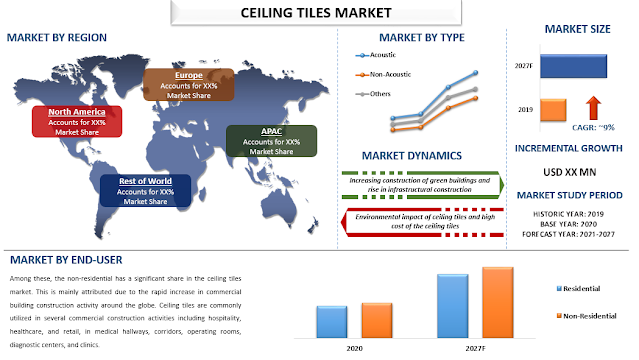Ceiling Tiles Market - Industry Size, Share, Growth & Forecast 2028 | UnivDatos
Ceiling tiles or panels refer to lightweight construction materials primarily utilized in ceilings applications to enhance the interior exquisite. Ceiling tiles are mainly made from gypsum, metals, mineral fiber, PVC, wood, and others. These tiles provide numerous benefits over conventional cement-based ceilings, such as high thermal and acoustic insulation, better recyclability, easy installation, low-cost maintenance and repair, and improved aesthetics, among others. Owing to the above-mentioned properties, ceiling tiles are widely adopted for several construction activities across multiple sectors such as residential, retail, hospitality, healthcare, corporate, and others. The expanding construction industry coupled with the growing number of modern infrastructural projects is augmenting the market for ceiling tiles. Furthermore, the rising urbanization and the growing consumer inclination towards false and pleasing appealing ceiling structures are also fuelling the demand for ceiling tiles. Besides, the growing utilization of ceiling tiles in commercial buildings, such as multiplexes, shopping malls, and business centers for decorative and soundproof interiors is also augmenting the market growth.
Download Free Sample of this Report - https://univdatos.com/get-a-free-sample-form-php/?product_id=22972
According to UnivDatos Market Insights (UMI)’ research report “Global Ceiling Tiles Market”, the market is expected to showcase a growth of around 9% during the forecast period. The growing utilization of ceiling tiles in commercial buildings, such as multiplexes, shopping malls, and business centers for decorative and soundproof interiors is augmenting the market growth. Additionally, various countries’ governments are investing in the construction and renovation of schools, hospitals, transport infrastructures, and public offices would drive the market for ceiling tiles.
Based on material, the market is categorized into gypsum, mineral fiber, metallic, calcium silicate, PVC, and others. Among these, mineral fiber has a prominent share in the ceiling tiles market as it offers benefits such as sound insulation, durability, resistance to fire, and light reflectance. They are extensively used in non-residential buildings such as offices, hospitals, retail stores, and others.
Download Free Sample of this Report - https://univdatos.com/get-a-free-sample-form-php/?product_id=22972
Based on end-user, the market is categorized into residential, non-residential, and others. Among these, the non-residential has a significant share in the ceiling tiles market. This is mainly attributed due to the rapid increase in commercial building construction activity around the globe. Ceiling tiles are commonly utilized in several commercial construction activities including hospitality, healthcare, and retail, in medical hallways, corridors, operating rooms, diagnostic centers, and clinics.
Asia-Pacific has a considerable share of the ceiling tiles market
The growing construction industry in the Asia-Pacific region helped the region to obtain a considerable position in the ceiling tiles market. Further, improving per-capita income, and improving consumer spending power are encouraging consumers for more spending on their comfort, and improving lifestyles are increasing the demand for improved infrastructure for residential buildings and commercial buildings, such as multiplexes, shopping malls, and business centers. Furthermore, factors such as significant population growth, urbanization, and ongoing commercial and residential remodeling operations would boost the regional market.
For More Informative Information, Please Visit Us – https://univdatos.com/report/ceiling-tiles-market/
According to UnivDatos Market Insights (UMI)’, the key players with a considerable market share in the global ceiling tiles market include Armstrong World Industries Inc., Saint-Gobain Gyproc, SAS International, Renhurst Ceilings Pty Ltd., ROCKWOOL A/S, Knauf Gips KG, USG Corporation, Odenwald Faserplattenwerk GmbH, Hunter Douglas, and Byucksan Corporation. These companies are taking several strategic decisions to meet the growing demand and increase their market share.
“Global Ceiling Tiles Market” provides comprehensive qualitative and quantitative insights on the industry potential, key factors impacting sales and purchase decisions, hotspots, and opportunities available for the market players. Moreover, the report also encompasses the key strategic imperatives for success for competitors along with strategic factorial indexing measuring competitors’ capabilities on different parameters. This will help companies in the formulation of Go to Market Strategies and identifying the blue ocean for its offerings.
Market Segmentation:
1. By Material (Gypsum, Mineral Fiber, Metallic, Calcium Silicate, PVC, and Others)
2. By Type (Acoustic, Non-Acoustic, and Others)
3. By End-User (Residential and Non-Residential)
4. By Region (North America (United States, Canada, Rest of North America), Europe (Germany, France, United Kingdom, Italy, Spain, Rest of Europe), Asia-Pacific (China, Japan, India, Australia, Rest of APAC), and Rest of World)
5. By Company (Armstrong World Industries Inc., Saint-Gobain Gyproc, SAS International, Renhurst Ceilings Pty Ltd., ROCKWOOL A/S, Knauf Gips KG, USG Corporation, Odenwald Faserplattenwerk GmbH, Hunter Douglas, and Byucksan Corporation)
Key questions answered in the study:
1. What are the current and future trends of the global ceiling tiles industry?
2. How the industry has been evolving in terms of material, type, and end-user?
3. How the competition has been shaping across the countries followed by their comparative factorial indexing?
4. What are the key growth drivers and challenges for the global ceiling tiles industry?
5. What are the customer orientation, purchase behavior, and expectations from the global ceiling tiles suppliers across various regions and countries?
Labels: Ceiling Tiles Market



0 Comments:
Post a Comment
Subscribe to Post Comments [Atom]
<< Home